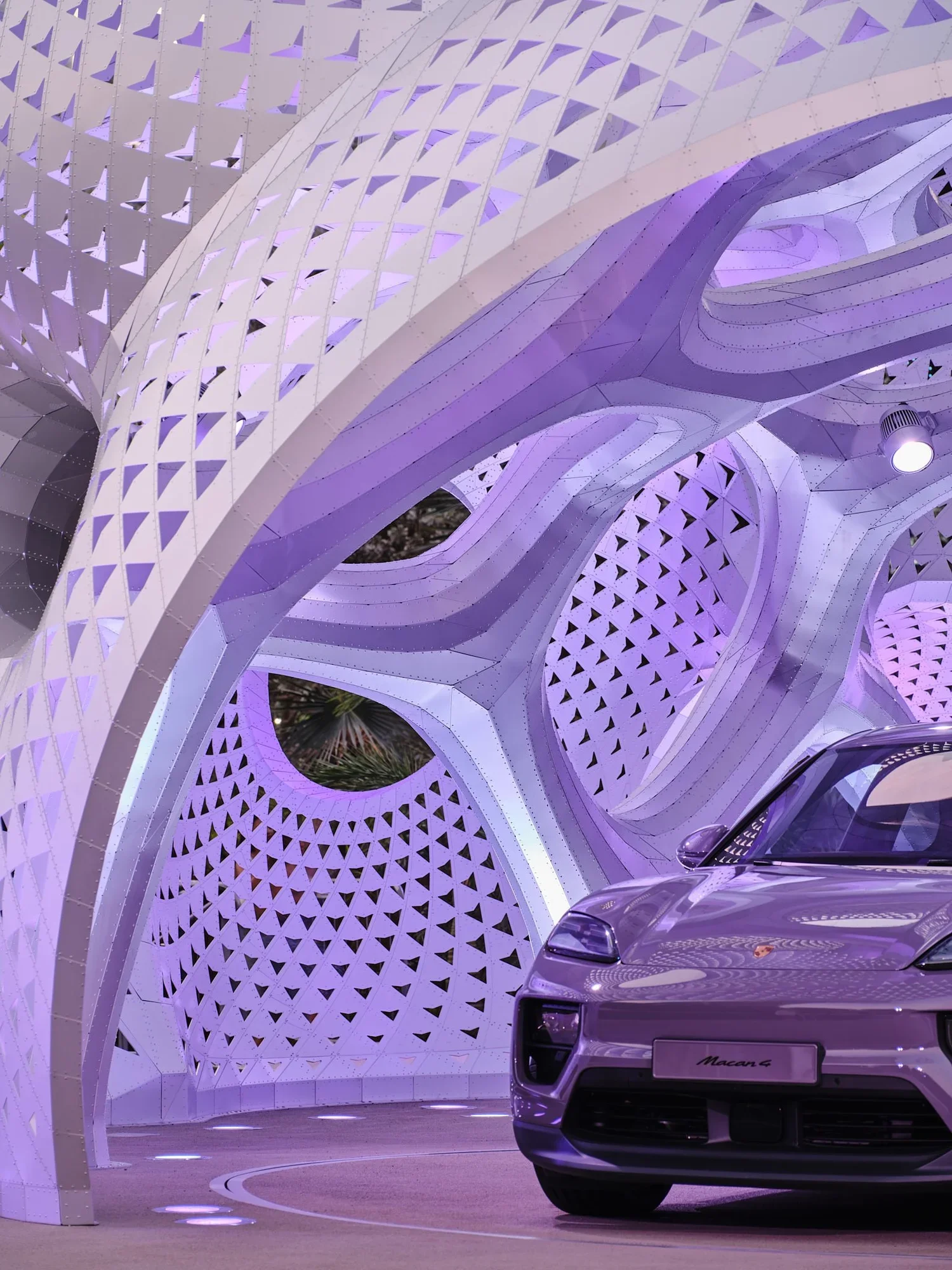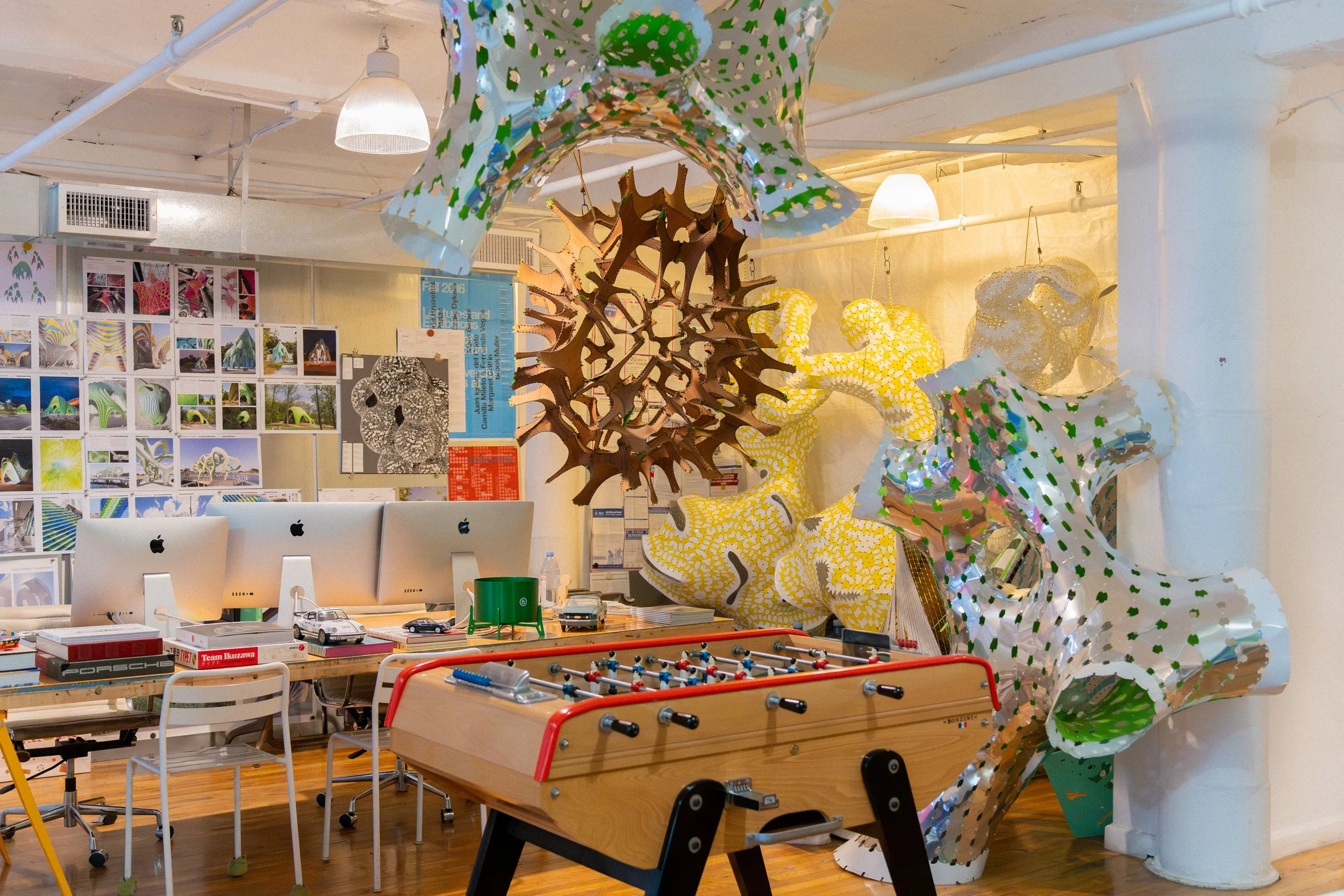
C.03
MARC FORNES AT HIS STUDIO
On a quiet street in Brooklyn, behind a discreet entrance, lies THEVERYMANY, Marc Fornes’s studio. Inside, colour spills over every surface: brilliant fragments, half-finished models, vintage toys, prototypes in candy tones. From the ceiling hangs an undulating piece; in a corner, a full-scale piece of a pavilion built on another continent. The space feels less like an office and more like the inside of a restless mind, each corner holding traces of years of experiments.
The invisible core of this practice is a lattice of algorithms and code orchestrating every curve and fold. Without scripts and parametric models, most of these complex geometries would be impossible to create. What can be imagined and what can be built are bridged by Marc Fornes's programming, fusing creative intuition with algorithmic rigour.
THEVERYMANY is not just calculation: it is exploration and play. Each curve reveals detours, errors, and discoveries —a process that transforms as much as it produces. Amid the burst of forms and colours, questions arise: How does it all come together? How can something so intricate emerge from so little?
Visiting this studio is like stepping into the backstage of a unique kind of theatre, where the scenery is made of building pieces and the scripts are yet to be written. Here, the process permeates everything, inviting us to marvel not only at what has been built, but at all the ways it might begin again.
THEVERYMANY operates globally, with completed works in North America, South America, Europe and Asia. Commissioners of Marc Fornes/THEVERYMANY include Google, Porsche, Louis Vuitton, and Selfridges London—the last in collaboration with Yayoi Kusama. Fornes’s work has been acquired and displayed by institutions and galleries around the world including the Centre Pompidou (Paris), where Y/STRUC/SURF is part of the permanent collection, the FRAC Centre (Orleans, FR), and the Storefront for Art and Architecture (New York). He has also exhibited at the Guggenheim, Art Basel Miami, Art Paris, and sold at auction at Phillips.
Interview by Asiel Nuñez | Edition by Juan Cantú and Candela de Bortoli | Photography by Classics Of The Future, unless otherwise specified. | Video by Tomas Orrego
INSIDE MARC FORNES’S STUDIO
Asiel Nuñez: You like to refer to your work as “engineering wonder”. Can you explain what this term means to you?
Marc Fornes: I think the phrase engineering wonder carries multiple layers. It speaks to the tension—and the balance—between technical precision and emotional experience. On the one hand, it's about the art of engineering, such as designing a bridge—a discipline grounded in performance, structure, and rigour. But on the other hand, it's also about fantasy—about creating spaces that transport you, that momentarily lift you out of reality. While our research is deeply serious, the outcome is meant to make you forget all that engineering and simply feel. It's about the moment you lose yourself, first in the environment, then in your own thoughts. So, for us, engineering wonder isn’t just a phrase; it’s a practice of crafting that sense of awe with intention and specificity.
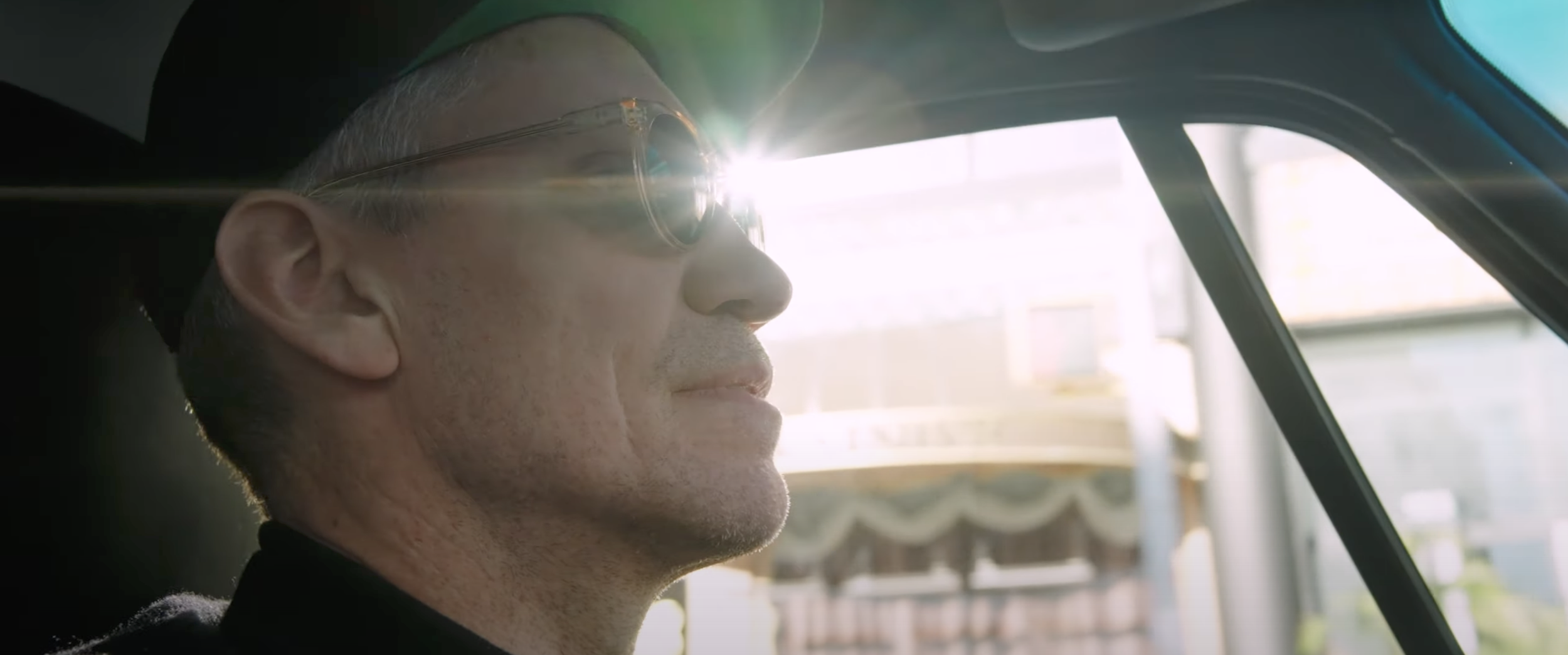
“…oNCE YOU’RE DRIVING, YOU DON’T WANT TO THINK ABOUT [THE CAR’S ENGINEERING]. YOU WANT TO JUST ENJOY THE RIDE. YOU WANT TO LOSE YOURSELF IN THE MOTION, tHE MOMENTUM, tHE THRILL.”
FORNES DRIVING HIS CAR - IMAGE © PORSCHE
Where does your fascination with the duality between engineering and wonder, or experience, come from?
I think it started with where I grew up, right on the border between France and Germany. I’m French, I carry a French passport, but culturally, so much around me was German—the food, the traditions, the mentality. Just across the border was the Autobahn, that stretch of highway with no speed limit. And I’ve always been fascinated by it. Because you don’t just drive on the Autobahn with any car. You need something engineered for it—something that can go fast, brake fast, respond instantly to the tiniest shift in conditions. That’s precision. That’s control.
But once you’re driving, you don’t want to think about all that. You want to just enjoy the ride. You want to lose yourself in the motion, the momentum, the thrill. And to me, that’s exactly what our work is about. In the studio, everything is about detail—the technical logic, the making, the constraints. But the end result? That should feel effortless. You shouldn't have to think about how it was made. You should just feel something.
So, in a way, our projects are like those high-performance machines—deeply engineered, but built to deliver an experience that feels fluid, emotional, even dreamy. That’s why I often mention Porsche, for example. German engineering is a great parallel to what we do: it’s extremely precise, but it exists to support a kind of escape.
IMAGES OF MARC FORNES’S PROJECT FOR LOUIS VUITTON ‘PAVILION NOMAD’. PHOTOGRAPHY © naaro
You recently designed a two-car garage for Porsche, and you own a Porsche yourself! Would you say you are a Porsche fan?
Yes, I am! With Porsche, especially for those who really know the brand, it’s about what’s inside. I’m particularly fascinated by the air-cooled models—a very specific era that represents a kind of purity, German engineering at its finest. These are cars designed to be driven, and driven fast.
I once spoke with Michael Mauer [the current Chief Designer at Porsche and responsible for the 911 models], and he told me something that really stuck. At Porsche, they’re intentionally keeping as few digital controls as possible. Because when you’re driving over 200 kilometres per hour on the Autobahn, you can’t afford to scroll through menus. You need to be able to let go and grab back instantly. So, they keep physical buttons on the steering wheel—it’s about tactile control, about immediacy. You don’t want something square or stylised—you want performance you don’t have to think about. He even joked that Porsche might be the last brand to keep a round steering wheel. And that actually makes a lot of sense.
That fascinates me, because it’s the same in our practice. At THEVERYMANY, we’re detail-oriented and equally obsessed with precision. We’ll spend hours debating which type of rivet to use, even if they all have the same structural capacity. For most architects, that’s a decision the structural engineer makes. But for us, that’s just the starting point. We don’t stop at construction documentation. We go all the way to what we call fabrication files, essentially the shop drawings for the entire project. There’s a shared commitment to control, to refinement—not for its own sake, but in service of something that ultimately feels effortless.
ALUMINIUM SAMPLES AT THE STUDIO
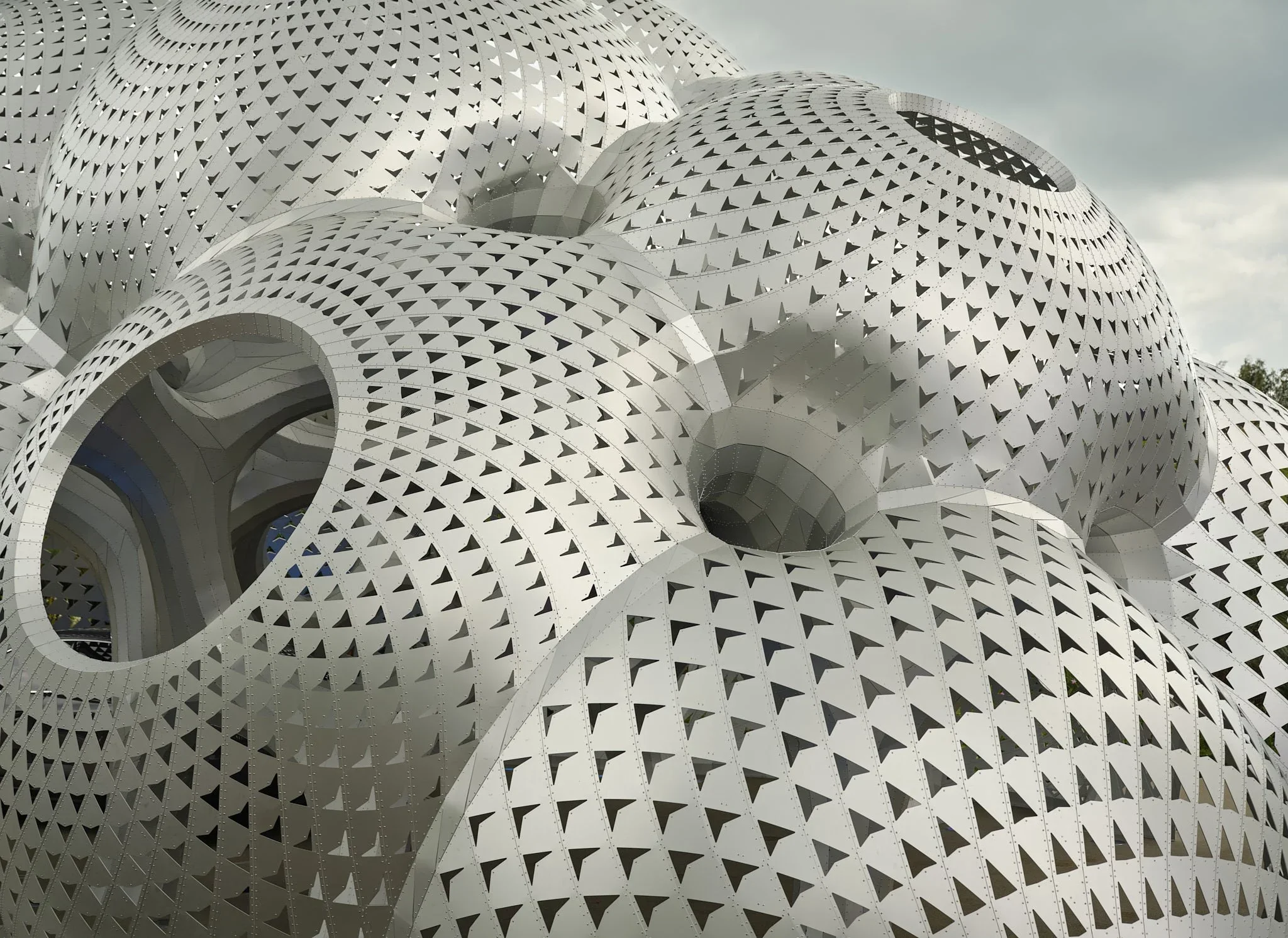
MARC FORNES X PORSCHE ‘MY TWO-CARS GARAGE’. PHOTO © DOUBLESPACE
‘MY TWO-CARS GARAGE’ PROJECT MODEL AT THE STUDIO
ONE OF FORNES’S JOUSTRA TOY CARS
I’ve noticed a lot of toy cars around the office.
Yes! I’ve always been fascinated by vintage toy cars, especially one specific brand called Joustra, short for Jouets de Strasbourg [Toys of Strasbourg]. I’m actually from Strasbourg in France, and many of those models from the '70s and '80s were Porsches, which I loved for two reasons. First, there’s the sense of pursuit, almost like developing a project. It’s about the search: finding the right people, the right design, the right fit. Then there’s that second phase—once the car is made and it’s out in the world. Just like a finished project, it’s no longer in your hands. It takes on a life of its own.
And I love the fact that none of the toys that I collect are pristine. They will have a broken windshield and some patina behind the wheels, just as a car would age to some extent.
And for me, there's nothing worse than actually discovering one of those still in its original box. It means it has never been played with, which is the worst nightmare and failure of the toy designer.
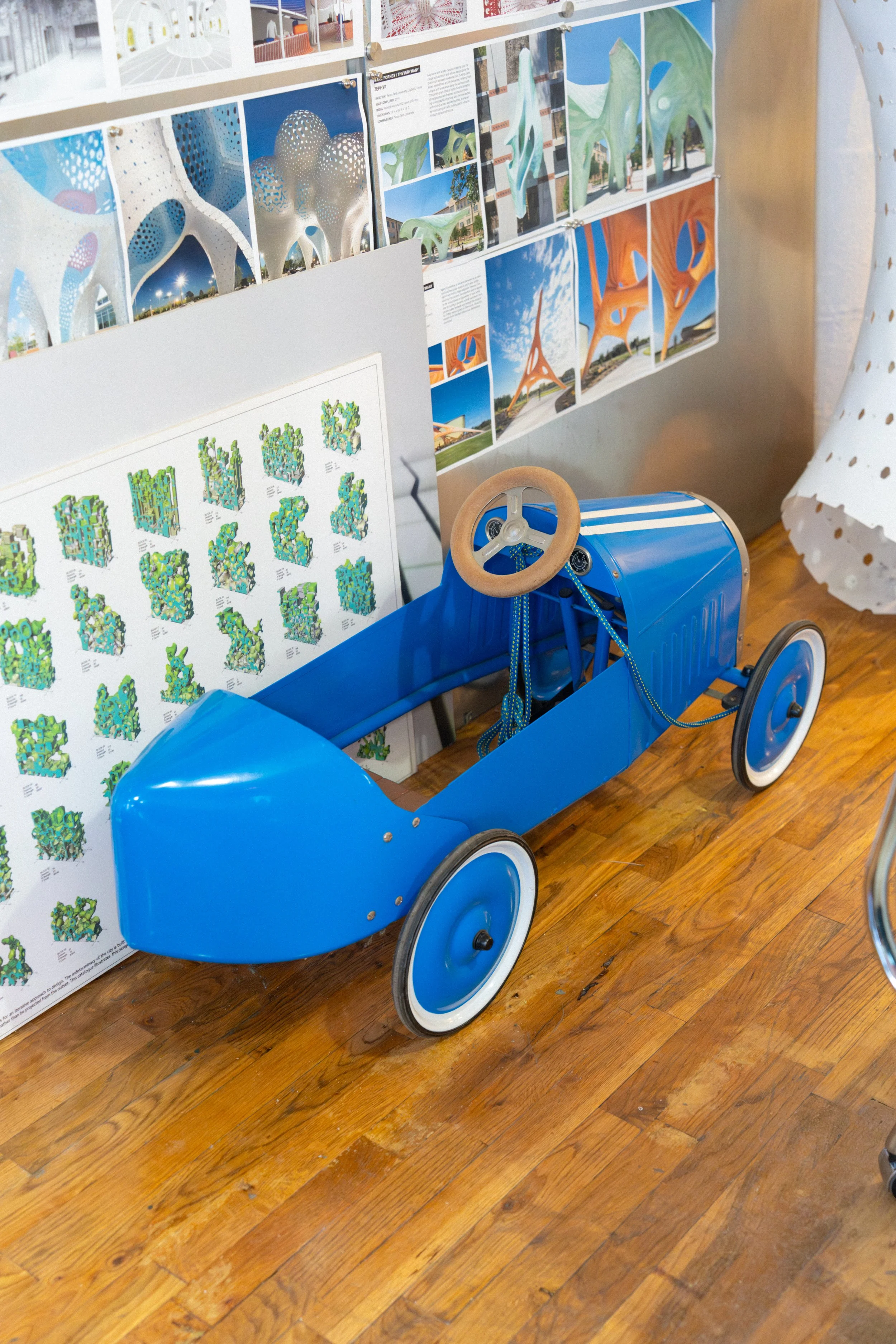
"THIS IS MY DAUGHTER’S FIRST CAR, WHICH I’M VERY PASSIONATE ABOUT. WE HAD TO BRING IT FROM EUROPE, BECAUSE IT WAS A PRESENT FROM HER GRANDPARENTS, SO IT HAD TO BE PACKED AS SMALL AS POSSIBLE INTO THE AIRPLANE.”
That is interesting! Your work being rooted in controlled engineering and precise craftsmanship, how do you approach failure?
For a long time, I gave a lecture series focused entirely on our failures. But failure, in this context, wasn’t always dramatic, though that did happen from time to time. We had some early projects actually collapse inside a gallery! More often, though, it was about recognising the small, embedded failures in every project. You start to see that something doesn’t need to be a complete disaster to be considered a failure. Sometimes it just means things could have been done faster or more efficiently. Or maybe it works, but it’s not scalable.
For instance, I’ve hit the upper limits of what’s possible with certain material systems. That, too, is a kind of failure. It pushes you to step back and ask: how do I scale this up? Does that mean fewer parts? Bigger parts? Thicker material? And how will those changes ripple through the entire design approach?
We’ve learned a huge amount through these kinds of setbacks. With aluminium, for example, we could probably write a PhD on what we now know about painting and protecting it. But again, I really want to stress that failure doesn’t have to mean catastrophe. It can just mean that next time, you realise the paint finish looks great, but it takes too long to apply. Or it’s too expensive. Or it looks great, but touch-ups are a nightmare. Or maybe the touch-ups work well, but the finish doesn’t hold up as well as the previous one. Those are all small failures, but they’re invaluable lessons.
PROJECTS WALL AT THE STUDIO
You seem to work a lot with aluminium.
Over time, we’ve primarily used aluminium—particularly very thin sheets—for several reasons.
First, aluminium doesn’t rust, so it holds up exceptionally well over time. You’re never at risk of losing the structure due to corrosion. Second, it’s incredibly lightweight. As you can probably tell from our prototypes, one of the core principles in the studio is that every piece, every element of the 3D puzzle, should be able to be carried by hand. We never want to rely on cranes or heavy-lifting equipment during the installation process. Aluminium also makes assembly easier. It’s soft enough to bend to a specific radius and curves without creasing or marking, which gives us a lot of flexibility in form.
That said, aluminium isn’t the only material we use. In our early projects, we experimented with all sorts of ultra-thin materials. [Points to a model in the studio] that one, for example, is made from extremely thin veneer.
We’ve also explored composites. In fact, we created one of the first carbon fibre shells ever used in architecture. But when you're doing public work and presenting your materials to a committee, aluminium tends to be much easier to defend and less intimidating than composites, which can still feel experimental to some.
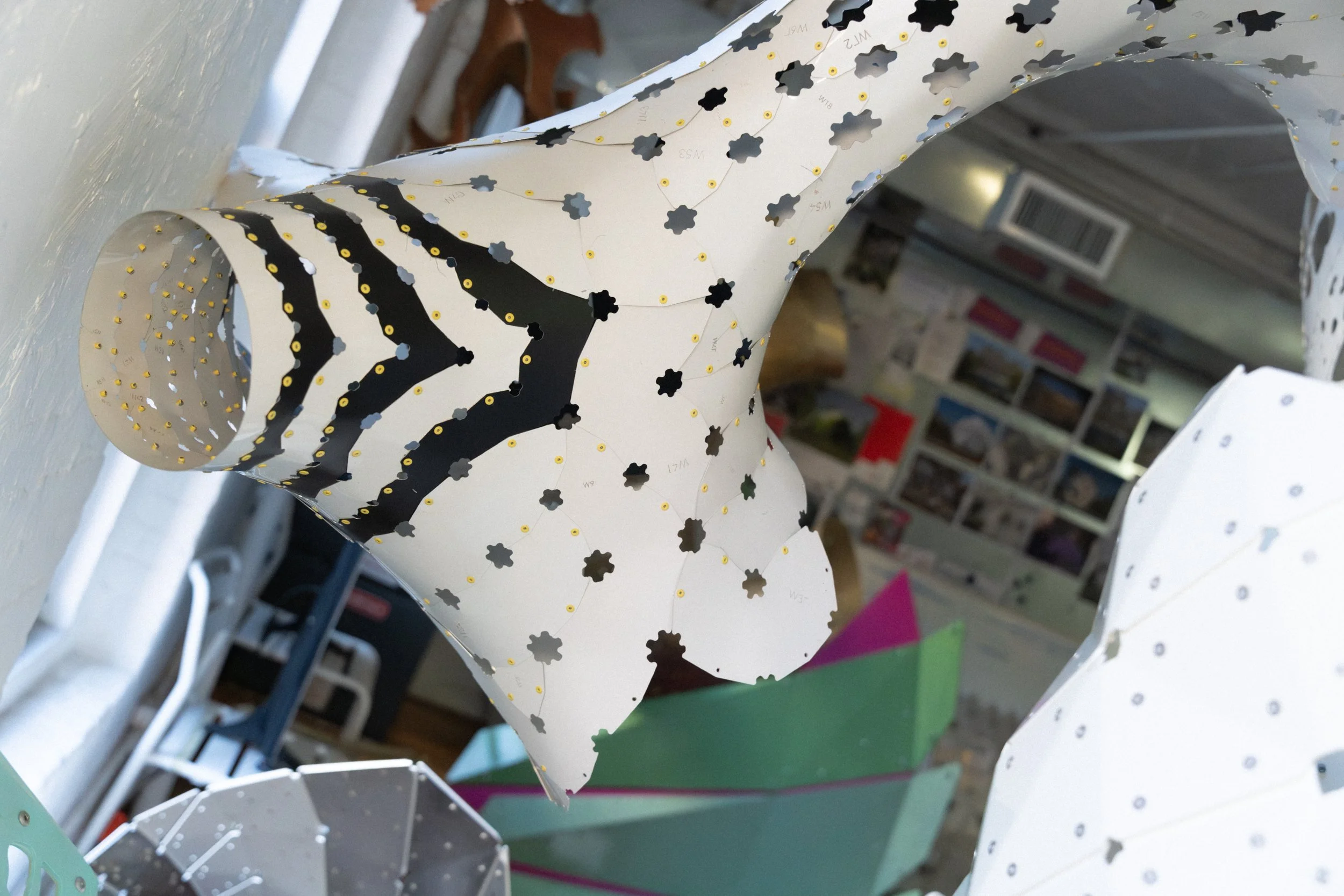
PROTOTYPES AT THE STUDIO
I find that some of these pieces are like volumes and others are more like shells. Do you define these as different types of pieces, or not necessarily?
There are definitely different typologies and morphologies—we can look at some of the prototypes in the studio. But regardless of the form, the guiding principle remains simple:
The skin is the structure.
And the skin must stay extremely thin, partly for economic reasons. To make that possible, we rely on maximising double curvature in the design. The more double curvature we have, the stiffer the structure becomes, even with very thin material. To achieve that, we carefully control the radius in both directions. For example, we lean toward more tubular shapes, which have a very tight radius in one direction. When a pure tubular form isn't feasible, because of the activities that the geometry needs to host, we break it down into smaller elements, each with tighter curves. That way, we can ensure rigidity and thinness in the skin, even in a more compound form.
FORNES SHOWING US HIS WORKS AT THE STUDIO
Take Félix Candela, for example. Architects often praise his work for its performative efficiency. They tend to see his architecture as geometrically optimised, especially because he was able to achieve such thin layers of concrete at the top of his shells. But what people often forget is that the bottom of those shells is actually quite thick, and that’s because of the way forces are distributed. We discovered this ourselves, in a very empirical way, when we tried to replicate one of his hyperbolic paraboloid forms as a prototype. We ran it through our own digital truss system and quickly saw that without enough structural return to the ground—or without sufficient double curvature—the whole thing would collapse.
That’s exactly the point of building these prototypes: to uncover those kinds of structural realities through direct experimentation.
‘PILLAR OF DREAMS’ PROJECT BY MARC FORNES/ THEVERYMANY. GIF COURTESY OF MARC FORNES/THEVERYMANY
‘PILLAR OF DREAMS’ PROJECT BY MARC FORNES/ THEVERYMANY. VIDEO © naaro
3D PRINTED MODELS AT THE STUDIO
You also like to experiment with colour. Usually, architects stick to the inherent colour of the material and are hesitant to take risks. What role does colour play in your work?
Colour is a really interesting topic for me, partly because it is a risk. There’s always that fear about durability, about falling into trends. And colour trends change constantly.
Someone well-known here in New York once told me, "If you can’t make your project interesting, make it big. And if you can’t make it big, make it red." And in a way, that’s the exact opposite of what we’re trying to do in the studio.
We’re not choosing a single colour for a project or assigning different colours to different parts in a kind of modernist way. What we’re interested in is the difference between colour and colouration.
For us, colouration means that each component is one colour, but when all the parts come together, they produce gradients, double gradients, checkered effects, checkers with gradients, and so on. You can really start to refine that. The idea is that the colouration emerges from the geometry—it builds on what’s already there.
So instead of using colour as a layer of taste or decoration, we let it respond to features such as curvature, surface orientation, or other inherent properties of the form. In that way, colour becomes supportive of the geometry. It enhances what the form is already doing.
And today, with the aid of computational tools, this kind of approach has become much more accessible. You can easily assign attributes such as colour across a whole system or population of objects and start to experiment in a way that’s both deliberate and dynamic.
ILLUSTRATION OF ‘MARQUISE’ PROJECT, COLORATION STRATEGY.
COURTESY OF MARC FORES/THEVERYMANY
‘MARQUISE’ PROJECT BY MARC FORNES/ THEVERYMANY.
PHOTO © naaro
‘WANDERWALL’ PROJECT BY MARC FORNES/THEVERYMANY. PHOTO © naaro
We often associate computation with optimisation and efficiency. What about aesthetics? How do you embed it within your design process?
I like to describe it as precise indetermination. It’s precise because when you code, you’re writing in a very specific syntax. It's structured, it follows rules, and you're translating your own thoughts into a computational language. You're fully in control of that logic.
However, it’s also indeterminate, because as you write more complex scripts—layering multiple instructions, multiple agents—it becomes challenging to predict the outcome fully. You might be setting clear parameters, but due to the number of variables and interactions, the result can still surprise you. So, on one hand, you have total control through the code’s precision. On the other hand, the complexity introduces a level of unpredictability—something that often leads to unexpected and unique outcomes.
What we do in the studio is ask very specific questions, often grounded in real-world challenges: fabrication, assembly, logistics. Then we explore which algorithm might best solve that problem. And through that problem-solving process, distinct aesthetic qualities begin to emerge. They’re not decorative—they’re intrinsic to the logic of the solution. That’s where computation becomes powerful: not just as a tool for optimisation, but as a source of innovation, both technically and visually.
THEVERYMANY STUDIO STILLS
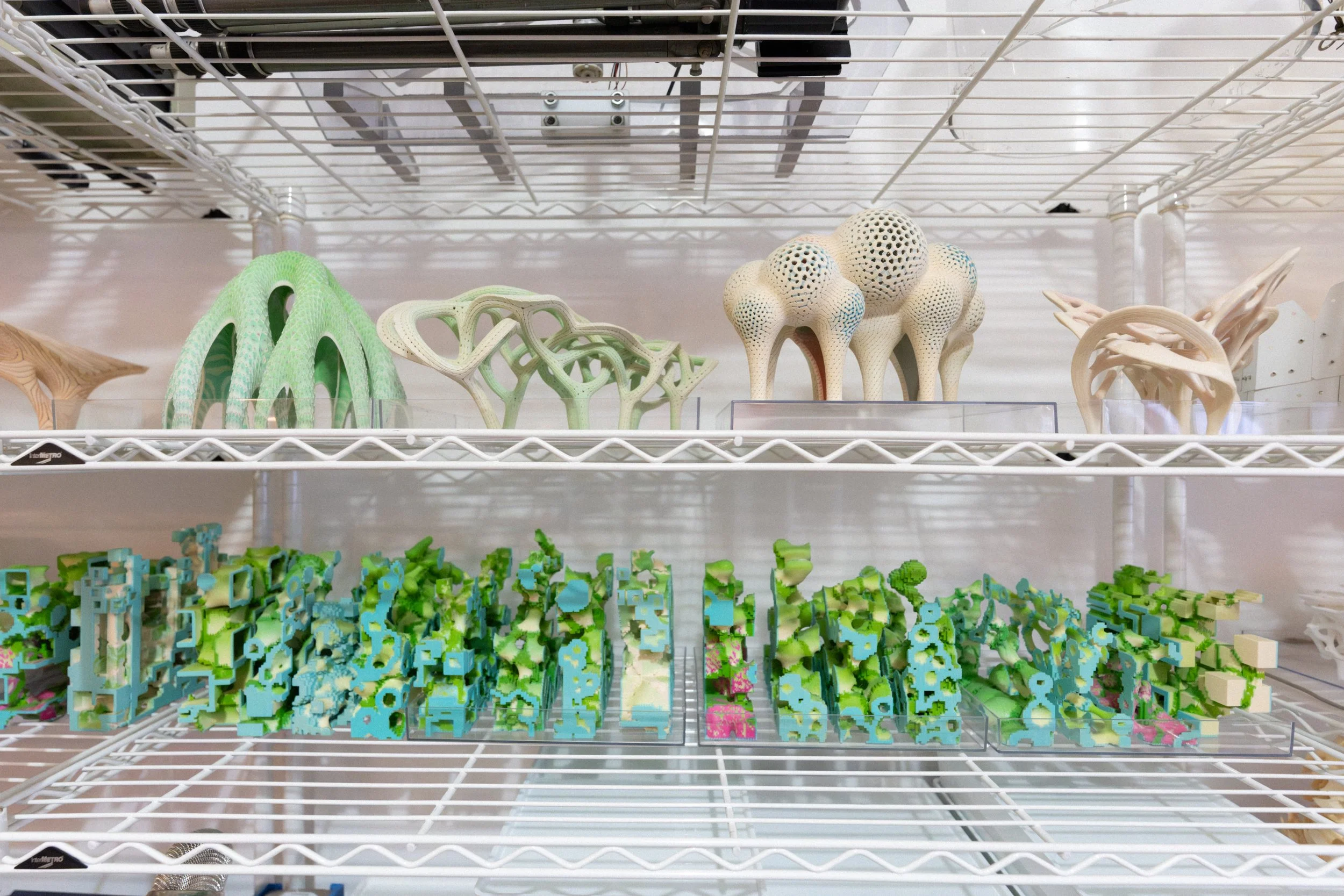
Your design process involves a kind of writing—coding—and, much like books, your projects evoke a sense of fantasy. Is there a specific piece of literature that has influenced your work?
Absolutely. I’ve always had a strong interest in literature. In fact, there are a couple of authors I sometimes refer to in relation to our work: Jules Verne and Lewis Carroll.
Books like Twenty Thousand Leagues Under the Sea or Journey to the Centre of the Earth had a big influence on me. I read them in high school, and what stayed with me was this recurring idea of the vector: of discovery, descent, exploration. You’re diving into the ocean, diving into the earth. That sense of venturing into the unknown resonates with our process, because a lot of what we do has very little precedent.
When you walk into one of our projects, you often don’t know what to expect. We’re so used to spaces defined by boxes and right angles—but suddenly, in our work, there are no edges. And when there are no edges, there’s nowhere to cast a shadow. Your eyes don’t receive the same visual cues. It takes more time to understand the depth and the volume. And that’s precisely the point—just like in Verne’s novels, you have to travel through space to understand it truly.
And eventually, the space takes you somewhere else. First, it guides you physically, and then, over time, it pulls you inward—into your own imagination. That’s why we often refer to our projects as vectors. They translate you from a very real, physical setting into something more introspective or emotional.
Lewis Carroll is another important reference. At first glance, his work may seem fantastical and whimsical, but if you go deeper, there’s a rigorous logic behind it. After all, he was a mathematician. And we like that kind of duality. In our own work, there’s often an initial sense of surprise or even disorientation. But as you stay with it, a structure begins to reveal itself. There’s an internal logic at play.
So yes, I think literature—text, narrative, language—plays a huge role. Not only in how we conceive the work, but in how we hope others might experience it.
‘BOOLEAN OPERATOR’ BY THEVERYMANY. GIF © naaro




























